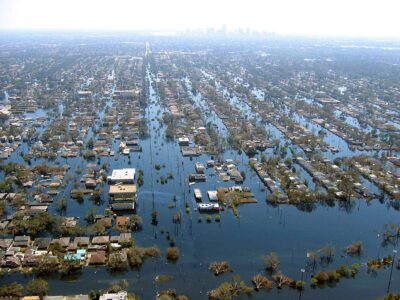by John Mutter

It has been one year since hurricane Katrina laid waste to New Orleans and a sizeable stretch of the Gulf Coast. What made that event a disaster, however, happened well before the storm actually came ashore.
With hurricanes, the rule for survival is simple — get out! If you get out you will probably live; if you stay you run a good risk of being killed. The failure to evacuate the city is what killed so many people two days later on August 31, and those who failed to order the evacuation are responsible, not Nature. As Spike Lee’s stunning documentary chronicles the initial failure was magnified by callous and inept disaster management that lead to more misery and killed even more people than the hurricane itself.
In the days after the storm, much was said about how Katrina had made America look like a poor country most often because of the reported incidents of looting, with black people behaving lawlessly. We now know that those reports greatly exaggerated the truth. What really makes us look like a poor-world country is the fact that the most vulnerable families were permitted to endure the greatest suffering. The abject failure of our emergency institutions to properly respond echoes the poor world also. We did add our own twist. The utter abandonment of the sick and elderly of all races is unique.
Nature is blind to social class and economic status, but the reality is that the poor die in greater numbers and endure higher economic losses during disasters. Figures from the United Nations Development Programme show that people in countries ranked among the lowest 20 percent in the Human Development Index are 10 to 1,000 times more likely to die in a natural disaster than people from countries in the top 20 percent.
Socially marginalized people are always at greatest physical risk because they occupy the riskiest environments: they live on steep landslide prone slopes of the barrios that surround major cities in poor countries. They live in swamps and flood-prone riverbanks of urban peripheries. They live in poorly built houses that collapse easily when shaken by earthquakes or a wrecked by flood waters. They lived in the 9th Ward of New Orleans.
How many people did Katrina actually kill? It turns out it depends on how you count. It’s just like the way we count the death toll from the New York heat wave. If you only count those who died by the medically recognized condition of heat stroke, then not too many people died at all. But if you count those people who died of heart failure or respiratory failure, isolated and alone in the intense heat of stifling apartments, deaths that likely would not have occurred in cooler conditions, then the number would be much higher. How much higher is very hard to say.
Whom should we count as victims of Hurricane Katrina? Certainly we have to count everyone who died when they inhaled the toxic muck of the waters that rushed into low lying neighborhoods from the beached levees. And we have to count those who were crushed in collapsed buildings or struck by flying debris driven by the hurricane’s intense winds.
But do we count those who were shot by the police in the act of looting? What about those who died in the Superdome, including one who died of a drug overdose and another who took his own life? Do they count? If you died in a hospital or nursing home of an illness that you contracted well before the hurricane because your essential life support systems were interrupted, do you count as a hurricane victim?
I have been trying to answer these questions ever since the hurricane hit and a year later I don’t have an answer. I want very much to know the real count; all the people who died both directly and indirectly, people who would not have died otherwise. And not just on the very day of the hurricane but in the tragically long aftermath. More than that, I want to know how they died. What were the circumstances of their last moments? How many were so despairing that they took their own lives? How many had death from a so-called natural cause accelerated by the trauma of the hurricane? And just as important I want to know what the lives of the victims were like because the sad uncomfortable fact is that how a person lived is deeply significant in determining whether they died and how a person dies in a natural disaster.
A folk song written about the Galveston Flood of 1900 recounts that “Death came howling from the ocean/Death called you’ve got to go.” Nature will always send death howling from the oceans and global warming may cause the howl to be much louder in the future. It’s not 1900 any more and we are a rich country now. We have the power and the moral responsibility to ensure that all lives are valued and protected, regardless of age or other social and economic factors. Don’t blame Nature.



